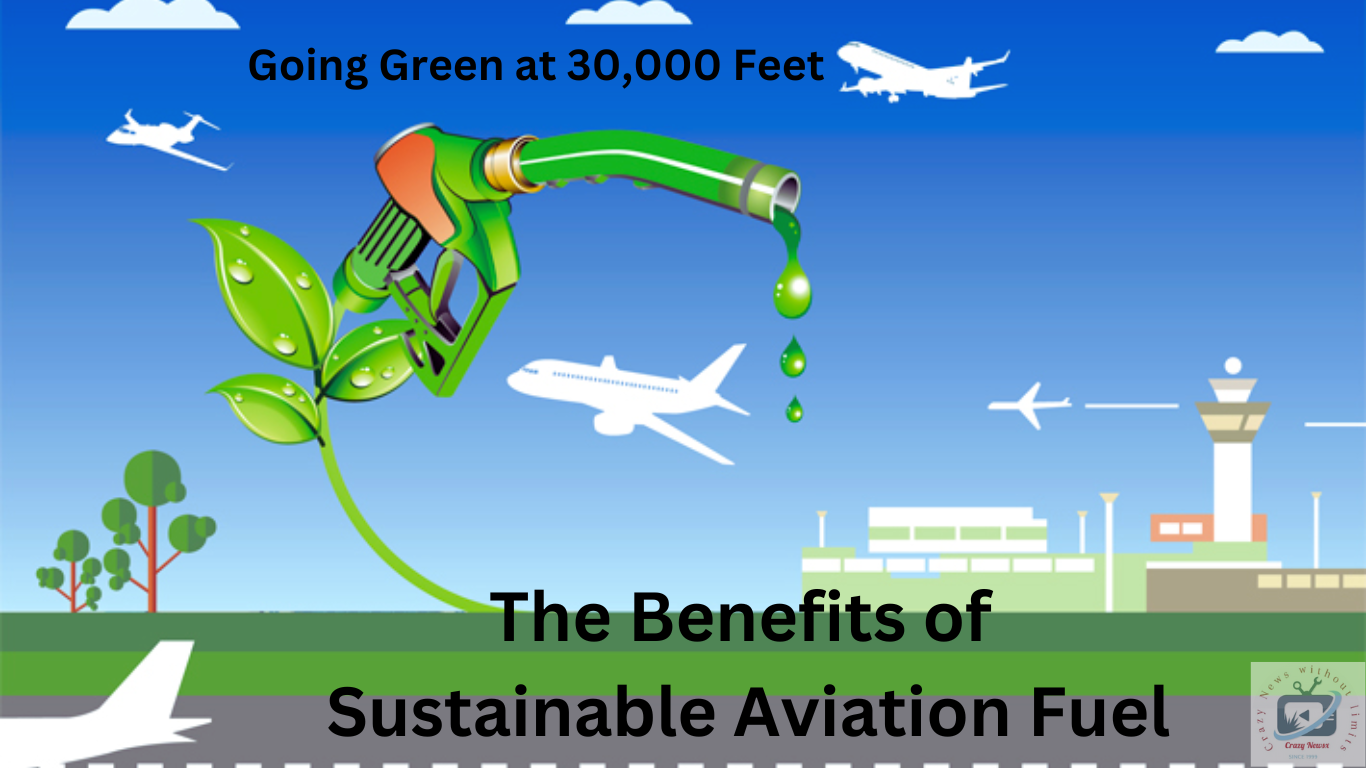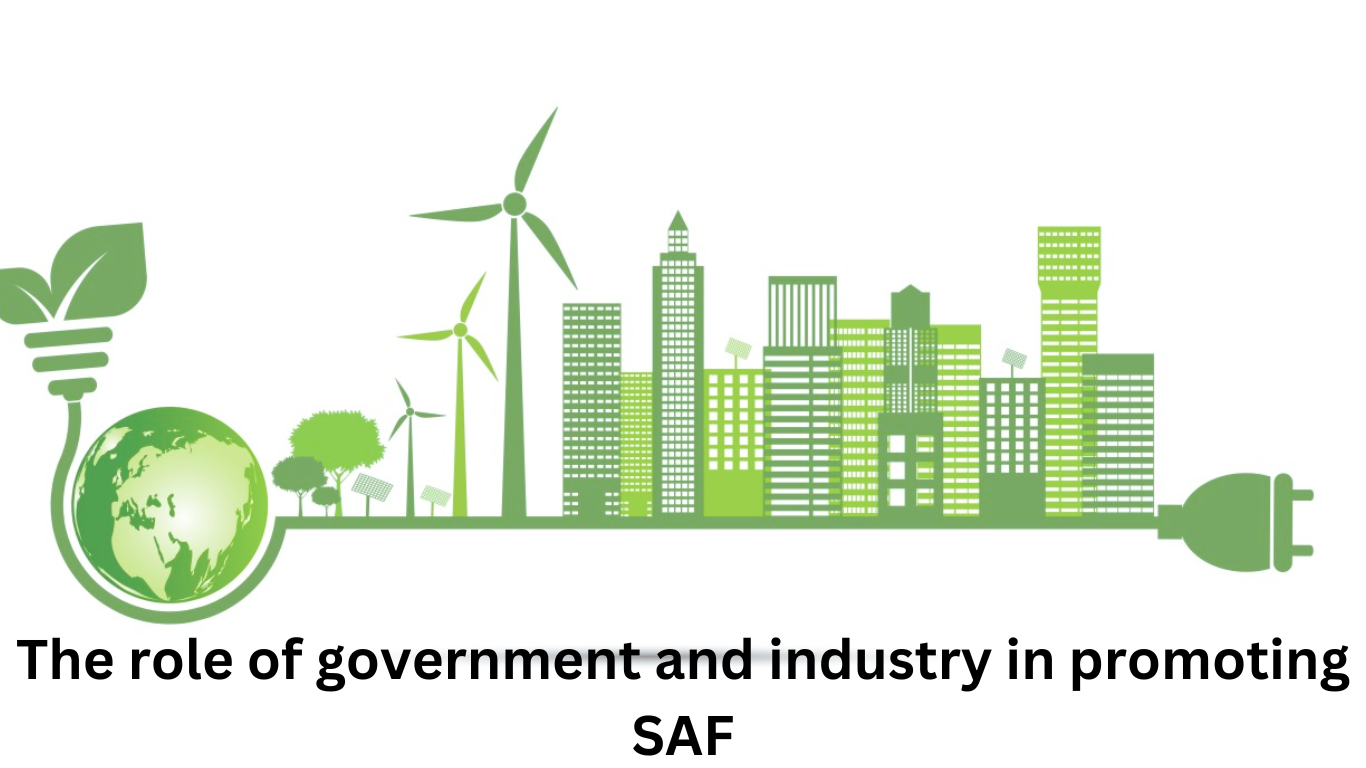The aviation industry has long been known as one of the biggest sources of carbon emissions, but it is also one of the most difficult industries to decarbonize.
The industry has been exploring different ways to reduce its carbon footprint, and Sustainable Aviation Fuel (SAF) is one of the most promising solutions.
SAF is a drop-in replacement for traditional jet fuel, made from renewable resources such as plant oils, municipal waste, and agricultural residues. It has the potential to reduce greenhouse gas emissions by up to 80%, making it a key component in the aviation industry’s efforts to become more sustainable. In this blog post, we will dive deep into the world of SAF, its benefits, and how it is paving the way to a greener future in aviation.
Introduction to Sustainable Aviation Fuel (SAF)

In recent years, the aviation industry has faced increasing scrutiny regarding its impact on the environment. As concerns grow over greenhouse gas emissions and the contribution of air travel to climate change, the search for sustainable solutions has become more urgent than ever. One promising development in this quest for a greener future is the emergence of Sustainable Aviation Fuel (SAF).
Sustainable Aviation Fuel, also known as bio-jet fuel or alternative jet fuel, is a renewable and low-carbon alternative to traditional fossil-based jet fuel. It is derived from sustainable sources such as plant biomass, waste oils, and other organic materials. Unlike conventional jet fuel, SAF has the potential to significantly reduce CO2 emissions and other harmful pollutants, making it a crucial tool in the aviation industry’s efforts to mitigate its environmental impact.
One of the key advantages of SAF is its compatibility with existing aircraft and infrastructure. It can be blended seamlessly with conventional jet fuel, requiring no modifications or changes to aircraft engines. This means that airlines can begin incorporating SAF into their operations without the need for extensive investments or fleet upgrades.
Moreover, SAF offers a unique opportunity to reduce the aviation industry’s dependence on fossil fuels. As it is derived from sustainable sources, it provides a pathway towards achieving carbon neutrality and reducing the sector’s overall carbon footprint. By embracing sustainable aviation fuel, airlines and industry stakeholders can take a proactive stance in addressing environmental concerns while still meeting the increasing demand for air travel.
The growing adoption of SAF has also led to positive economic and social impacts. The production and use of sustainable aviation fuel can create new jobs and stimulate economic growth in regions that invest in its development. Additionally, it can enhance the industry’s reputation and appeal to environmentally conscious travelers, attracting a growing segment of consumers who prioritize sustainability in their travel choices.
In conclusion, Sustainable Aviation Fuel represents a significant step towards a greener future in aviation. Its potential to reduce CO2 emissions, lower environmental impact, and promote sustainability makes it a crucial component of the industry’s efforts to address climate change. By embracing SAF, airlines, airports, and aviation stakeholders can pave the way towards a more sustainable and environmentally responsible aviation sector.
The environmental impact of traditional aviation fuel
The environmental impact of traditional aviation fuel cannot be overlooked. The use of fossil fuels in the aviation industry has contributed significantly to greenhouse gas emissions and climate change. The combustion of jet fuel releases carbon dioxide (CO2), nitrogen oxides (NOx), and other pollutants into the atmosphere, leading to air pollution and the depletion of the ozone layer.
Carbon dioxide is a major greenhouse gas that traps heat in the atmosphere, contributing to global warming. The aviation industry is responsible for around 2% of global CO2 emissions, and this number is expected to rise as air travel continues to grow. Additionally, nitrogen oxides emitted by aircraft engines contribute to the formation of smog and acid rain, further harming the environment and human health.
Moreover, traditional aviation fuel is derived from non-renewable sources such as crude oil, which leads to the depletion of natural resources and contributes to geopolitical tensions. The reliance on finite fossil fuel reserves poses a significant risk to the aviation industry’s long-term sustainability.
Recognizing these environmental challenges, the aviation industry has been actively seeking alternative solutions to reduce its carbon footprint. One promising solution is the development and use of Sustainable Aviation Fuel (SAF), also known as biojet fuel or renewable aviation fuel.
SAF is produced from sustainable feedstocks such as agricultural residues, waste oils, and algae. Unlike traditional fossil-based jet fuel, SAF significantly reduces carbon emissions, as it has a lower carbon intensity and does not release additional fossil carbon into the atmosphere when burned. It is a drop-in replacement for conventional jet fuel, meaning it can be used in existing aircraft without requiring modifications or changes to infrastructure.
By transitioning to SAF, the aviation industry can significantly reduce its environmental impact and move towards a greener and more sustainable future. It offers the potential to achieve substantial emissions reductions, improve air quality, and mitigate climate change. Additionally, the production of SAF promotes the development of a circular economy by utilizing waste and by-products from other industries as feedstock.
In conclusion, the environmental impact of traditional aviation fuel is a pressing concern that needs to be addressed. The adoption of Sustainable Aviation Fuel presents a viable and promising solution to reduce carbon emissions, enhance air quality, and pave the way to a greener future in aviation.
What is Sustainable Aviation Fuel (SAF)?
Sustainable Aviation Fuel (SAF) is an innovative solution that holds the potential to revolutionize the aviation industry and pave the way to a greener future. As the world becomes more conscious of the environmental impact of greenhouse gas emissions, the aviation sector has been under scrutiny due to its significant contribution to carbon dioxide emissions.
SAF is an alternative to conventional fossil-based aviation fuel, derived from renewable and sustainable feedstocks. It is produced using advanced technologies that convert biomass, waste oils, and other sustainable sources into a clean-burning fuel. The production process ensures a significant reduction in greenhouse gas emissions compared to traditional jet fuel.
One of the key advantages of SAF is its compatibility with existing aircraft and infrastructure. It can be used as a drop-in fuel, meaning it can be blended with conventional jet fuel without requiring any modifications to aircraft engines or fueling systems. This makes it an attractive option for airlines looking to reduce their carbon footprint without incurring significant costs or operational changes.
Moreover, SAF offers numerous environmental benefits. It has the potential to reduce up to 80% of CO2 emissions on a life cycle basis compared to conventional jet fuel. It also reduces the emission of other pollutants, such as sulfur oxides and particulate matter, leading to improved air quality around airports and along flight routes.
Furthermore, SAF supports the circular economy by utilizing waste and by-products from various industries as feedstocks. This not only reduces dependence on fossil fuels but also contributes to waste reduction and resource efficiency.
The adoption of SAF is gaining momentum globally, with airlines, fuel producers, and governments recognizing its potential to mitigate climate change and achieve sustainability goals. Several airlines have already started incorporating SAF into their operations, with commitments to increase its usage in the coming years.
In conclusion, Sustainable Aviation Fuel is a promising solution that addresses the environmental challenges faced by the aviation industry. With its ability to significantly reduce greenhouse gas emissions, support the circular economy, and maintain compatibility with existing infrastructure, SAF is paving the way towards a greener future in aviation.
How does SAF differ from traditional aviation fuel?
Sustainable Aviation Fuel (SAF) is paving the way to a greener future in the aviation industry. As concerns about climate change and carbon emissions continue to grow, the aviation sector is under increasing pressure to find more sustainable alternatives to traditional aviation fuel.
So, how does SAF differ from traditional aviation fuel? The primary difference lies in its composition and production process. Traditional aviation fuel, also known as Jet A or Jet A-1, is derived from fossil fuels such as crude oil. It is a carbon-intensive fuel that releases significant greenhouse gas emissions when burned.
On the other hand, SAF is produced from sustainable feedstocks, such as plant oils, agricultural residues, or waste materials. These feedstocks can be renewable and have a lower carbon footprint compared to fossil fuels. SAF can be produced through various processes, including hydro-processing, gasification, and fermentation, resulting in a fuel that has similar properties to traditional aviation fuel.
One crucial aspect of SAF is that it can be blended with traditional aviation fuel without requiring any modifications to existing aircraft or infrastructure. This means that SAF can be seamlessly integrated into the current aviation system, offering a viable solution for reducing emissions without disrupting operations.
Furthermore, SAF offers significant environmental benefits. It has the potential to reduce greenhouse gas emissions by up to 80% compared to traditional aviation fuel on a lifecycle basis. This reduction in emissions contributes to mitigating climate change and helps the aviation industry meet its sustainability goals.
Additionally, SAF has the advantage of being compatible with existing aircraft engines, ensuring reliable performance and safety. It undergoes rigorous testing and certification processes to meet the same high standards as traditional aviation fuel.
The adoption of SAF by airlines and aviation stakeholders is gaining momentum globally. Many airlines have already started incorporating SAF into their operations, either through voluntary initiatives or regulatory requirements. Governments and industry organizations are also supporting the development and use of SAF through various incentives and policies.
In conclusion, SAF represents a significant shift towards a greener and more sustainable aviation industry. Its composition, production process, and environmental benefits differentiate it from traditional aviation fuel. By embracing SAF, the aviation sector can reduce its carbon footprint, contribute to global efforts in combating climate change, and pave the way for a more sustainable future in aviation.
Benefits of using SAF in aviation

The benefits of using Sustainable Aviation Fuel (SAF) in aviation cannot be overstated. As the aviation industry seeks to reduce its carbon footprint and contribute to a greener future, SAF emerges as a promising solution to mitigate the environmental impact of air travel.
Firstly, SAF significantly reduces greenhouse gas emissions compared to conventional jet fuel. It is produced from renewable and sustainable sources such as biomass, waste oils, or agricultural residues. By utilizing these feedstocks, SAF can achieve up to an 80% reduction in lifecycle carbon emissions when compared to traditional fossil-based aviation fuel. This reduction plays a crucial role in combating climate change and meeting ambitious emission reduction targets set by the aviation industry.
Secondly, SAF has the potential to improve local air quality around airports. Conventional jet fuel emits various pollutants, including sulfur compounds and particulate matter, which contribute to air pollution and have adverse effects on human health and the environment. In contrast, SAF has lower sulfur content and produces fewer harmful emissions, thereby reducing the negative impact on local air quality.
Moreover, SAF offers a viable solution to address concerns over resource availability and energy security. As traditional fossil fuel reserves are finite and subject to geopolitical uncertainties, the use of SAF diversifies the energy sources for aviation. By harnessing renewable feedstocks, SAF reduces dependence on fossil fuels and enhances energy independence, making aviation more resilient to supply disruptions.
Furthermore, the adoption of SAF can drive innovation and create new economic opportunities. The production and utilization of SAF require investments in research, development, and infrastructure. This stimulates growth in the renewable energy sector and fosters the emergence of new green technologies. It also presents opportunities for job creation and economic development in regions where SAF production facilities are established.
In conclusion, the benefits of using Sustainable Aviation Fuel in aviation are multifaceted and far-reaching. From substantial greenhouse gas emissions reduction to improved air quality and enhanced energy security, SAF represents a significant step towards a greener and more sustainable aviation industry. Embracing SAF not only aligns with environmental goals but also presents economic and technological opportunities for a brighter and cleaner future in aviation.
Challenges and limitations of SAF adoption
While Sustainable Aviation Fuel (SAF) holds great promise for reducing the environmental impact of the aviation industry, it is important to acknowledge the challenges and limitations that come with its adoption.
One major challenge is the limited availability and production capacity of SAF. Currently, SAF production is significantly lower compared to conventional jet fuel production. This scarcity is mainly due to the higher cost of producing SAF and the limited number of production facilities. Scaling up production to meet the demands of the aviation industry remains a significant hurdle.
Another limitation is the feedstock availability for SAF production. SAF can be produced from various renewable sources such as biomass, waste oils, and agricultural residues. However, the availability and sustainability of these feedstocks vary across regions. Ensuring a consistent and reliable supply of sustainable feedstocks is crucial for the widespread adoption of SAF.
Furthermore, the certification and regulatory framework for SAF need to be strengthened. Clear and internationally recognized sustainability standards are necessary to ensure that SAF meets the required environmental criteria and does not contribute to deforestation, land-use change, or other negative impacts. Developing robust certification processes and frameworks will be essential in building trust and confidence in SAF as a viable and sustainable alternative to conventional jet fuel.
Economic viability is also a challenge in SAF adoption. Currently, the production cost of SAF is higher than conventional jet fuel, making it less economically attractive for airlines. However, as technology advances and economies of scale are achieved through increased production, the cost of SAF is expected to decrease, making it more financially viable for airlines.
Despite these challenges, the aviation industry is actively working towards overcoming them. Collaboration between stakeholders, including airlines, fuel producers, governments, and environmental organizations, is crucial in driving the development and adoption of SAF. Investment in research and development, policy support, and financial incentives can help accelerate the transition to a greener future in aviation.
While there are obstacles to overcome, the potential benefits of SAF are significant. By reducing greenhouse gas emissions and dependence on fossil fuels, SAF can play a vital role in mitigating climate change and creating a more sustainable aviation industry.
Current initiatives and progress in the development of SAF
The aviation industry has long been under scrutiny for its environmental impact, particularly in terms of greenhouse gas emissions. However, in recent years, there has been a growing focus on finding sustainable alternatives to conventional jet fuel. This has led to the development of Sustainable Aviation Fuel (SAF), a promising solution that could pave the way to a greener future in aviation.
Numerous initiatives and collaborations are currently underway to advance the production and adoption of SAF. Airlines, aircraft manufacturers, fuel producers, and government agencies are coming together to explore and invest in this innovative fuel source. One notable example is the International Air Transport Association’s (IATA) commitment to achieving a 50% reduction in aviation emissions by 2050, with SAF playing a crucial role in reaching this target.
Several airlines have already taken significant steps towards incorporating SAF into their operations. For instance, Alaska Airlines has successfully completed numerous flights utilizing a blend of traditional jet fuel and SAF derived from sustainable feedstocks. Similarly, KLM Royal Dutch Airlines has been actively using SAF on select routes, significantly reducing their carbon footprint.
In addition to airline initiatives, various research and development projects are being conducted to enhance the production and scalability of SAF. Advanced technologies such as biomass conversion, thermal depolymerization, and gasification are being explored to efficiently convert a range of sustainable feedstocks into high-quality aviation fuels. These efforts aim to address challenges related to feedstock availability, cost competitiveness, and ensuring a consistent and reliable supply of SAF.
Furthermore, regulatory support and incentives are being introduced to encourage the widespread adoption of Sustainable Aviation Fuel (SAF). Governments around the world are implementing policies to promote the use of sustainable aviation fuels, including tax incentives, carbon pricing mechanisms, and mandates for blending Sustainable Aviation Fuel (SAF) with conventional jet fuel.
The progress made in the development of Sustainable Aviation Fuel (SAF) is undoubtedly promising. However, it is essential to continue investing in research, technological advancements, and infrastructure to accelerate its commercialization and widespread use. By embracing sustainable aviation fuel, the aviation industry can significantly reduce its carbon footprint and contribute to a greener and more sustainable future for air travel.
The role of government and industry in promoting SAF

The transition to sustainable aviation fuel (SAF) requires a collaborative effort between governments and industry players. Recognizing the urgent need to address climate change and reduce greenhouse gas emissions from the aviation sector, governments around the world are taking proactive steps to promote the adoption and production of SAF.
One of the key roles of government is to establish supportive policies and regulations that incentivize the production and use of SAF. This can include setting targets for the percentage of SAF in aviation fuel blends, providing financial incentives or grants for SAF producers, and implementing carbon pricing mechanisms that create a level playing field between conventional jet fuel and SAF. By creating a favorable regulatory environment, governments can stimulate investment and innovation in the Sustainable Aviation Fuel (SAF) industry.
Industry players, including airlines, aircraft manufacturers, and fuel producers, also play a crucial role in promoting SAF. Many airlines have made commitments to reduce their carbon footprint and have started incorporating SAF into their operations. By demonstrating the viability and benefits of SAF, these industry leaders are encouraging others to follow suit. Additionally, collaborations between airlines and fuel producers are driving the development of sustainable feedstocks and advanced conversion technologies, ensuring a reliable and scalable supply of SAF.
Partnerships between governments and industry are essential in scaling up SAF production and making it more cost-competitive. Through joint research and development initiatives, funding schemes, and knowledge sharing, governments and industry can work together to overcome technical and economic barriers, accelerate the deployment of Sustainable Aviation Fuel (SAF) , and achieve the ambitious sustainability goals set for the aviation sector.
In conclusion, the role of government and industry in promoting Sustainable Aviation Fuel (SAF) cannot be overstated. By aligning policies, providing support mechanisms, and fostering collaboration, they can create an enabling environment for the widespread adoption of SAF, paving the way to a greener future in aviation.
Future prospects and potential for SAF in aviation
The future prospects and potential for Sustainable Aviation Fuel (SAF) in the aviation industry are bright and promising. As the world shifts towards more sustainable practices, the aviation sector is actively seeking ways to reduce its carbon footprint and contribute to a greener future.
- One of the main advantages of Sustainable Aviation Fuel (SAF) is its compatibility with existing aircraft and infrastructure.
- Unlike other alternative fuels, SAF can be used in existing aircraft engines without the need for any modifications.
- This means that airlines can seamlessly integrate SAF into their operations, without incurring significant costs or disruptions.
- Moreover, Sustainable Aviation Fuel (SAF) has the potential to significantly reduce greenhouse gas emissions in the aviation industry.
- According to studies, Sustainable Aviation Fuel (SAF) can result in up to 80% reduction in carbon dioxide emissions compared to conventional jet fuel.
- This reduction is achieved through the use of renewable feedstocks, such as waste oils, agricultural residues, and algae, which have a lower carbon intensity compared to fossil fuels.
- The growing demand for air travel, coupled with increasing environmental concerns, has led to a surge in the development and production of Sustainable Aviation Fuel (SAF).
- Airlines, aircraft manufacturers, fuel suppliers, and governments around the world are investing in research and development to scale up the production of Sustainable Aviation Fuel (SAF) and make it more commercially viable.
Additionally, the adoption of Sustainable Aviation Fuel (SAF) can also have economic benefits. As the demand for Sustainable Aviation Fuel (SAF) increases, it will create new job opportunities in the renewable energy and biofuel sectors. It can also reduce the dependence on fossil fuel imports, providing energy security and stability for the aviation industry.
However, there are still challenges to overcome in the widespread adoption of Sustainable Aviation Fuel (SAF). These include the availability and scalability of sustainable feedstocks, the development of cost-effective production processes, and ensuring the long-term sustainability and traceability of the supply chain.
In conclusion, the future prospects for Sustainable Aviation Fuel (SAF) in aviation are promising, with the potential to significantly reduce carbon emissions and pave the way to a greener and more sustainable future. Continued investments, collaborations, and policy support are crucial to further develop and commercialize SAF, making it a viable and widely adopted alternative to traditional jet fuels.
Conclusion: SAF as a key driver for a greener future in aviation
In conclusion, Sustainable Aviation Fuel (SAF) holds immense potential as a key driver for a greener future in aviation. As the aviation industry continues to grow, it is crucial to address the environmental impact it has on our planet. SAF offers a promising solution by significantly reducing carbon emissions and dependence on fossil fuels.
By utilizing Sustainable Aviation Fuel (SAF), airlines can make a positive impact on the environment without compromising the efficiency and performance of their aircraft. The use of Sustainable Aviation Fuel (SAF) can lead to a substantial reduction in greenhouse gas emissions, thereby minimizing the industry’s contribution to climate change.
Moreover, SAF has the advantage of being compatible with existing aircraft and infrastructure, making it a viable and accessible alternative to traditional jet fuel. This means that airlines can seamlessly integrate SAF into their operations without requiring extensive modifications or investments.
Furthermore, the production of SAF promotes sustainable practices and the use of renewable resources. It encourages the development of innovative technologies and processes that harness the power of biofuels, waste-to-energy conversion, and other renewable feedstocks. This not only reduces carbon emissions but also supports the growth of the bioenergy sector and contributes to a more sustainable future.
In order to fully realize the potential of Sustainable Aviation Fuel (SAF), it is crucial for governments, industry stakeholders, and the aviation community to collaborate and invest in its development. This includes supporting research and development efforts, incentivizing the production and use of SAF, and establishing policies and regulations that promote its adoption.
While Sustainable Aviation Fuel (SAF) is not a standalone solution to the environmental challenges faced by the aviation industry, it plays a vital role in paving the way to a greener future. By embracing SAF, the aviation sector can demonstrate its commitment to sustainability, reduce its carbon footprint, and contribute to global efforts in combating climate change.
In conclusion, the adoption and widespread use of Sustainable Aviation Fuel is a crucial step towards achieving a greener future in aviation. It presents a viable and impactful solution to reduce carbon emissions, promote sustainability, and drive innovation in the industry. By embracing Sustainable Aviation Fuel (SAF), we can ensure that future generations can enjoy the benefits of air travel without compromising the health of our planet.
In conclusion,
- Sustainable aviation fuel (SAF) is paving the way to a greener future in aviation. As the aviation industry continues to grow and face increasing pressure to reduce its carbon footprint, SAF provides a viable solution. With its ability to significantly reduce greenhouse gas emissions, SAF offers a sustainable alternative to conventional jet fuel. By investing in research, development, and production of SAF, the aviation industry can play a crucial role in combating climate change and working towards a greener future. Let us take flight towards a sustainable tomorrow, where the skies are cleaner and our planet is preserved for generations to come.
- Know More Read About Sustainable aviation fuel (SAF)


